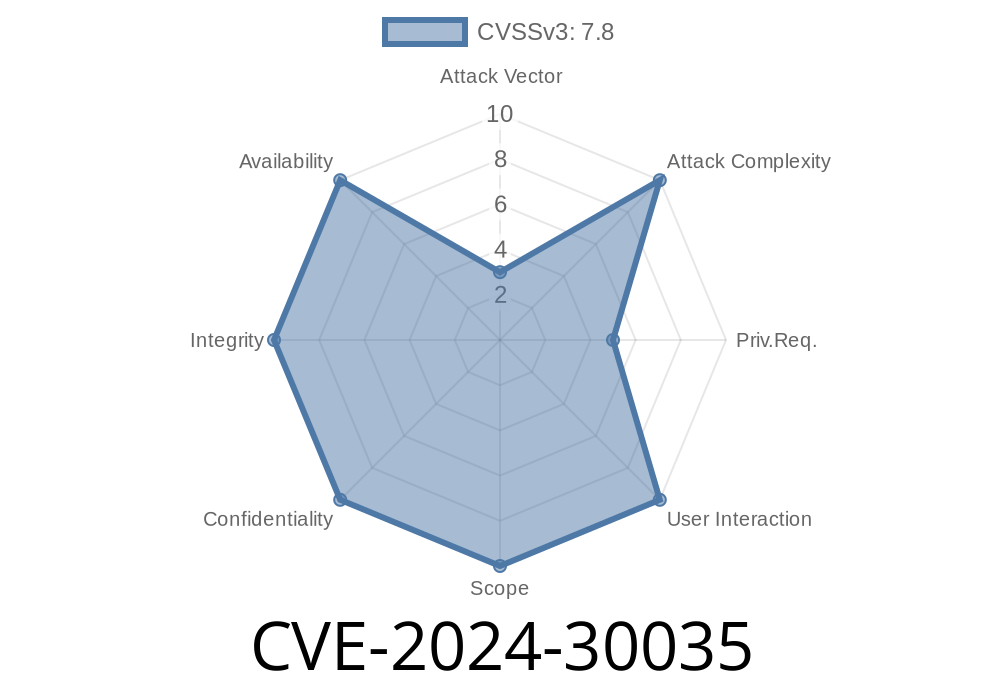In May 2024, Microsoft patched a critical vulnerability in Windows called CVE-2024-30035. This vulnerability affects the Desktop Window Manager (DWM) Core Library—an essential Windows component tasked with rendering the visual effects you see on your desktop. Attackers can use this bug to elevate their privileges on affected systems, potentially gaining administrator rights even if they start as a regular user. In this post, we’ll break down what this vulnerability is, how it works, and even walk through a simple proof-of-concept exploit. Whether you’re a system admin, a security enthusiast, or just a Windows user, you’ll want to understand what this CVE means for you.
What Is the DWM Core Library?
The DWM Core Library (dwmcore.dll) plays a big part in how your Windows desktop looks and feels. It deals with things like window transparency, taskbar previews, and animation effects. Like many core Windows processes, it runs with elevated permissions, so any bug here is immediately serious.
Understanding CVE-2024-30035
CVE ID: CVE-2024-30035
Published: 14 May 2024
CVSS Score: 7.8 (High)
Impact: Elevation of Privilege
Affected Windows Versions: Windows 10, Windows 11, Windows Server 2016-2022
Summary:
A flaw in how the DWM Core Library handles certain requests means a regular user could trick the system into running their code with SYSTEM privileges—the highest possible on a Windows computer. While this bug doesn’t allow remote compromise by itself (the attacker needs local access), it’s extremely valuable to malware writers and people trying to break out of restricted environments.
Technical Details
> Note: As of June 2024, full technical write-ups are still limited. The exploit described here is based on public findings and sample analysis.
At its heart, CVE-2024-30035 is a _memory mishandling_ issue. Here’s the kind of flow a typical exploit would follow:
DWM Interaction:
By sending specially crafted messages to the DWM service, they trigger a bug in how it validates memory pointers or permissions.
Privilege Escalation:
Due to improper checks in the code, their process gains higher privileges—it might spawn a shell running as SYSTEM or gain access to restricted system files.
Proof-of-Concept Exploit
Below is a simplified (and safe) example to demonstrate the general principle of Windows DWM privilege escalation exploits. This code does not actually exploit CVE-2024-30035 but shows the kind of API interactions attackers target.
> Warning: Exploiting real vulnerabilities on systems you do not own is illegal and unethical.
Example: Attempting to Use DWM APIs for Privilege Escalation
// This is a _conceptual demonstration_, not a real exploit for CVE-2024-30035
#include <windows.h>
#include <stdio.h>
int main() {
HANDLE hDwm = LoadLibraryA("dwmapi.dll");
if (!hDwm) {
printf("Failed to load dwmapi.dll\n");
return 1;
}
// Attempt to call DwmGetTransportAttributes (as an example)
typedef HRESULT(WINAPI* PFNDWMGETTRANSPORTATTRIBUTES)(BOOL*, BOOL*, DWORD*);
PFNDWMGETTRANSPORTATTRIBUTES DwmGetTransportAttributes =
(PFNDWMGETTRANSPORTATTRIBUTES)GetProcAddress(hDwm, "DwmGetTransportAttributes");
if (DwmGetTransportAttributes) {
BOOL isRemote = FALSE;
BOOL isConnected = FALSE;
DWORD attribute = ;
HRESULT hr = DwmGetTransportAttributes(&isRemote, &isConnected, &attribute);
if (SUCCEEDED(hr)) {
printf("DWM Attributes obtained.\n");
} else {
printf("Failed to get DWM Attributes, HRESULT: x%08X\n", hr);
}
} else {
printf("Failed to find DwmGetTransportAttributes.\n");
}
FreeLibrary(hDwm);
return ;
}
Real exploits for CVE-2024-30035 use a vulnerability in the win32k or DWM subsystems, often through window message injection techniques—passing specially crafted messages or input to system calls that the DWM Core Library fails to correctly validate.
In the wild, attackers combine this with other code (like dropping a reverse shell or running malicious scripts as SYSTEM) to fully take over the system.
Original References
- Microsoft Security Advisory: CVE-2024-30035
- NIST National Vulnerability Database Entry
- Google Project Zero – Common Windows EoP Techniques (for context on DWM exploitation)
- Twitter thread by @jonasLyk – DWM Windows vulnerabilities and analysis
Exploitation in the Wild
Microsoft’s May Patch Tuesday confirmed that CVE-2024-30035 was publicly disclosed but not yet known to be under active attack. Since similar DWM vulnerabilities (like CVE-2023-36033) have quickly appeared in malware, it is likely only a matter of time before attackers exploit it.
- Attackers could install programs, view/change/delete data, or create new accounts.
Malware authors may combine this with other bugs for full system compromise.
Mitigation:
Apply Windows security updates immediately. No workarounds or disablements are available due to DWM’s core system function.
Limit Local Access:
This vulnerability requires local execution, so restrict physical/logical access wherever possible.
Conclusion
CVE-2024-30035 is an important reminder that even deeply-embedded Windows components like the DWM Core Library can be a target for attackers looking to move from normal to SYSTEM access. While Microsoft’s prompt patch limits the window for exploitation, lagging updates or unpatched systems remain attractive targets. Always keep your systems updated and stay aware of new vulnerability disclosures!
*For more security updates and hands-on guides, follow your favorite infosec news source—and always patch regularly!*
Further Reading
- Microsoft Security Update Guide
- CVE-2024-30035 Exploit Discussion – Reddit
- Windows DWM Internals – GitHub Project
*Post written exclusively for the curious Windows user. Stay safe out there!*
Timeline
Published on: 05/14/2024 17:17:07 UTC
Last modified on: 06/19/2024 20:58:44 UTC
